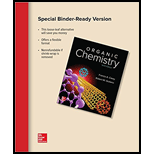
Concept explainers
Interpretation:
The structure that is not a permissible contributing one amongst the given structures is to be determined; the remaining three structures are to be ranked in the order of their contribution to the resonance hybrid; and the electron movement that connects these three resonance contributors is to be shown using curved arrows.
Concept introduction:
According to the resonance concept, Lewis formulas that have different distribution of electrons in their structure can be written for a single molecule. Lewis formulas that confer to a resonance hybrid can be made easier to understand by using curved arrows to represent the delocalized electrons.
Each structure contributing to resonance must have an equal total number of valence electrons and the same value of net charge. Among the various Lewis formulas written for a molecule, the formal charges on individual atoms may vary. Each structure contributing to resonance must have the same number of unshared electrons.
When two or more structures satisfy the octet rule, the major contributor structure is the one with the smallest separation of oppositely charged atoms. The contributor structure with the least number of formal charges is more stable.
Trending nowThis is a popular solution!

Chapter 1 Solutions
ORGANIC CHEMISTRY(LL)-W/ACCESS >CUSTOM<
- Of two possible structures A and B for the conjugate acid of guanidine, the more stable is the one that is better stabilized by electron delocalization. Which one is it? Write resonance structures showing this electron delocalization.arrow_forwardWhich of the two compounds shown below is more basic? You must rationalize your answer based on compound structure;arrow_forwardIn the spaces provided, indicate the type of bond, and the hybridized orbitals that overlap to form the bond.arrow_forward
- Write the heterolytic and homolytic equations of cleavage in the bonds of the following compounds shown with a linearrow_forwardConsider structure A, which other strucutre shown is the same as molecule A? and whyarrow_forwardGive a clear handwritten answer with explanation...give detailed answer.....given below some options in which choose the best answer that converts the bond line diagram below the given structure.arrow_forward
- Which of the following structural pairs represents contributors to a resonance hybrid? Explain – please show your work for clear understanding.arrow_forwardArrange the following molecules from its increasing stability.arrow_forwardProvide the mechanism for this reaction. Please show arrow movements, all line pairs, and formal chargesarrow_forward
 ChemistryChemistryISBN:9781305957404Author:Steven S. Zumdahl, Susan A. Zumdahl, Donald J. DeCostePublisher:Cengage Learning
ChemistryChemistryISBN:9781305957404Author:Steven S. Zumdahl, Susan A. Zumdahl, Donald J. DeCostePublisher:Cengage Learning ChemistryChemistryISBN:9781259911156Author:Raymond Chang Dr., Jason Overby ProfessorPublisher:McGraw-Hill Education
ChemistryChemistryISBN:9781259911156Author:Raymond Chang Dr., Jason Overby ProfessorPublisher:McGraw-Hill Education Principles of Instrumental AnalysisChemistryISBN:9781305577213Author:Douglas A. Skoog, F. James Holler, Stanley R. CrouchPublisher:Cengage Learning
Principles of Instrumental AnalysisChemistryISBN:9781305577213Author:Douglas A. Skoog, F. James Holler, Stanley R. CrouchPublisher:Cengage Learning Organic ChemistryChemistryISBN:9780078021558Author:Janice Gorzynski Smith Dr.Publisher:McGraw-Hill Education
Organic ChemistryChemistryISBN:9780078021558Author:Janice Gorzynski Smith Dr.Publisher:McGraw-Hill Education Chemistry: Principles and ReactionsChemistryISBN:9781305079373Author:William L. Masterton, Cecile N. HurleyPublisher:Cengage Learning
Chemistry: Principles and ReactionsChemistryISBN:9781305079373Author:William L. Masterton, Cecile N. HurleyPublisher:Cengage Learning Elementary Principles of Chemical Processes, Bind...ChemistryISBN:9781118431221Author:Richard M. Felder, Ronald W. Rousseau, Lisa G. BullardPublisher:WILEY
Elementary Principles of Chemical Processes, Bind...ChemistryISBN:9781118431221Author:Richard M. Felder, Ronald W. Rousseau, Lisa G. BullardPublisher:WILEY





